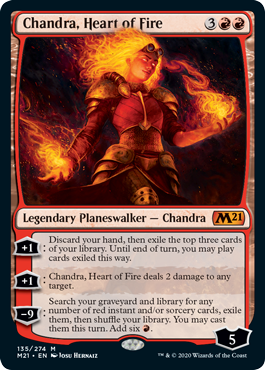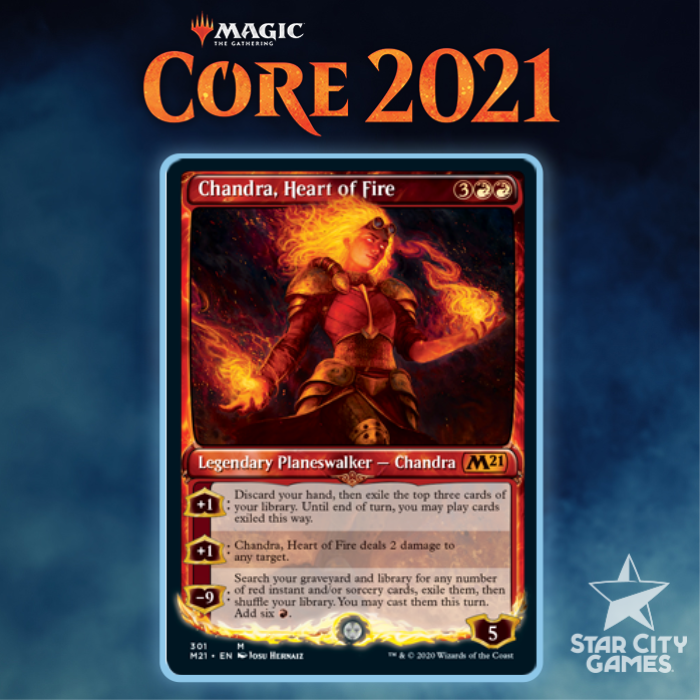It wasn’t all that long ago that I placed my bets on Liliana, Dreadhorde General being the most impactful card in War of the Spark. It seems silly now, but consider the context. Teferi, Hero of Dominaria and Vivien Reid were among the most important cards in Ravnica Allegiance Standard. For a couple of years, four- to six-mana planeswalkers had dominated Standard. Your goal in deckbuilding was to find the best way to support and leverage these haymakers that immediately made the game about the virtual and actual card advantage a powerful planeswalker could generate.
Fast forward to the present era, and copious amounts of mana-doubling and a group of absurdly pushed three-mana planeswalkers have made Ravnica Allegiance-era Magic, and the planeswalkers that supported it, look quaint by comparison. Magic is always in a state of flux though. A bevy of bans and a rotation on the horizon beg us to at least give some consideration to cards which embrace the old mode of operation. Beyond that, Lukka, Coppercoat Outcast made clear that, if the payoff is worthy, there’s still space for an expensive planeswalker in today’s Standard.

Planeswalkers are perhaps the only card type where a step-by-step restatement of the card text brings something worthwhile to an analysis. They’re often capable of achieving many different things, and consideration of how each ability links to the next hints strongly at a card’s potential.
First, I’ll note this is obviously a Chandra and therefore Chandra’s Regulator, Chandra’s Triumph, and Chandra’s Embercat are in play for a few months. Chandra’s Regulator is solid here, as all of Chandra, Heart of Fire’s abilities double well. The activated ability of the card seems completely acceptable in Big Red-style decks as well. I wouldn’t be shocked if Chandra’s Regulator saw the smallest bit of play.
Five loyalty with an immediate plus to six is certainly big enough to survive most turns. Add on the potential removal spell provided by Chandra, Heart of Fire’s second ability and I like her odds of surviving combat.
My method of card evaluation has shifted somewhat over the past six months. While most of my energy previously would be focused on consistency and acceptable fail rates, the pushed state of current Magic cards incentivizes me to consider optimal scenarios. When you contemplate the best version of Chandra’s first +1 ability, it is among the most powerful sources of raw card advantage we’ve ever seen on a planeswalker. Plus three cards is nothing to scoff at, even if you must jump through major hoops to gain that level of payoff.
[+1]: Discard your hand, then exile the top three cards of your library. Until end of turn, you may play cards exiled this way.
One of the most interesting points of Chandra’s first +1 is its ability to function as a reliable discard outlet. It is this portion of the card that first drew me to Chandra and inspired my first decks of Core Set 2021 preview season. More on this later.
Despite the potential upsides, there are some real weaknesses built into this mode of card “draw.” It really stands out to me that effects like Cathartic Reunion and Thrill of Possibility play terribly with this effect. While these cards seem important for decks that want redundant discard outlets, they will be the absolute blanks when revealed with Chandra.
You also need to be comfortable with losing all of your resources in the event that Chandra does not survive into your next turn. These holes in the first +1 ability make me believe that if Chandra, Heart of Fire is going to be a large part of Standard, its second +1 ability will have to shoulder the bulk of the burden. Luckily, I believe it’s more powerful than it appears at first glance.
[+1]: Chandra, Heart of Fire deals 2 damage to any target.
Unrestricted targeting on a repeatable effect like this is a surprisingly big deal. Chandra’s greatest moments will come from her ability to eliminate opposing planeswalkers. Narset, Parter of Veils and Teferi, Time Raveler routinely operate at low loyalty levels. Chandra’s ability to answer them while leaving behind a sticky threat will be critical for the next few months.
It is less clear how two damage will scale into the future, but the effect can almost never be rendered useless due to its lack of targeting limitations. I love the idea of Chandra just looming over the battlefield racking up splash damage and invalidating every two-toughness creature. It doesn’t hurt Chandra’s playability that the two-toughness crew includes some real powerhouses like Gilded Goose; Azusa, Lost but Seeking; and Priest of Forgotten Gods.
[-9]: Search your graveyard and library for any number of instant and/or sorcery spells, exile them, then shuffle your library. You may cast them this turn. Add six R.
Finally, we come to the ultimate. When it comes to large planeswalkers, we usually ask that the ultimate be game-winning. In Standard, Chandra comes up short. In the absence of Lightning Bolt or even Lightning Strike, it feels like the ultimate will have a hard time generating game altering bursts of damage. If you’ve kept Chandra on the battlefield long enough to achieve her ultimate, it’s likely that her card advantage and persistent damage have already placed you in a dominating position.
This isn’t to say that Chandra won’t occasionally grab a trio of Shocks and fire off the last bits of damage; it just doesn’t need to be your A-plan. In fact, I expect decks to include Chandra that have few or no targets for her ultimate. It’s just not the focal point of this card. It’s possible that Slaying Fire becomes playable at some point, and in that world, perhaps Chandra can actually burn opponents out.
These individual abilities paint an underwhelming picture of Chandra, but no ability exists in a vacuum. I can think of several decks that can leverage the vast majority of what Chandra brings to the table as part of their macro-plan.
Add four Chandra, Heart of Fire to:
Creatures (5)
Planeswalkers (4)
Lands (26)
Spells (21)

This deck is placing a large bet on the idea that an early- to mid-game Ugin, the Spirit Dragon will often be enough to carry a game on its own. When it isn’t, our goal is to keep a never-ending stream of hard-cast Ugins coming.
Chandra enables all aspects of this plan. It places Ugin into the graveyard early to be returned with Elspeth Conquers Death. It impedes aggression that could doom us before our expensive spells come online. And it does its best to keep a stream of Ugins coming in the late-game should our first attempt at Ugin be thwarted.
Ideally, we’re presenting enough ways to tax opposing Elspeth Conquers Death that one of our massive threats will eventually stick. The fact that Ugin and Chandra can both go face means that we don’t requiring anything resembling a true win condition and get to have a singular focus on controlling the battlefield and letting our haymakers speak for themselves.
Solemn Simulacrum is a needed boost for any fair deck like this. It gives us a realistic chance to hard-cast Ugin and is a fine Elspeth Conquers Death target itself. It also pushes me to think about Yorion and potential 80-card builds of the same approach. Again, add four copies of Chandra, Heart of Fire.
Creatures (9)
Planeswalkers (4)
Lands (36)
Spells (27)
- 2 Deafening Clarion
- 3 Solar Blaze
- 4 Slaying Fire
- 4 Thrill of Possibility
- 4 The Birth of Meletis
- 3 Omen of the Forge
- 3 Omen of the Sun
- 4 Elspeth Conquers Death
Sideboard

Archon of Sun’s Grace and Sparkhunter Masticore fit very well with the midrange gameplan of this approach and open plenty of potential avenues to chip damage victories. I love Sparkhunter Masticore’s ability to serve as yet another discard outlet.
There’s some inherent tension here between the blinkable permanents and Ugin’s minus ability, but the thought is that if you are minusing an Ugin, you are unlikely to be concerned about weakening a future Yorion blink. The biggest objection I have to these lists is the aforementioned lack of synergy between Thrill of Possibility and Chandra, Heart of Fire. Seems like the answer is to dabble in blue. Once more, add four copies of Chandra, Heart of Fire to the following deck.
Creatures (7)
Planeswalkers (8)
Lands (36)
Spells (25)
- 2 Deafening Clarion
- 2 Solar Blaze
- 4 Omen of the Sea
- 4 Thirst for Meaning
- 2 The Birth of Meletis
- 2 Omen of the Forge
- 3 Omen of the Sun
- 4 Elspeth Conquers Death
- 2 Shatter the Sky
Sideboard

Thirst for Meaning serves as the reliable discard outlet we needed that can still be cast with Chandra’s first +1 ability. Maybe this is the replacement for Jeskai Lukka? There are certainly some similarities. We have a very reasonable fair game combined with the capacity to cheat a game-warping permanent onto the battlefield. Granted, the pacing here doesn’t really compare with Jeskai Lukka, but that deck was an order of magnitude too good for Standard. Cheating Ugin onto the battlefield might constitute a fixed version that can still dominate.
I’ll be honest. I’m a little shook when it comes to card evaluation right now. The last few sets have brought game-breaker after game-breaker into the mix, many of which flew under the radar. Chandra certainly feels like a step down from that power level. That being said, I’m excited to play with these lists, particularly the Jeskai deck. I don’t know if Chandra will be an integral part of Ugin reanimation strategies, but it plays well with the colorless behemoth and has some explosive card advantage tacked on. Time will tell if it passes the now-sky-high bar for a five-mana planeswalker.


